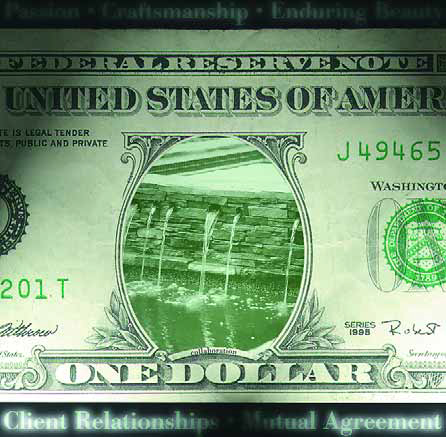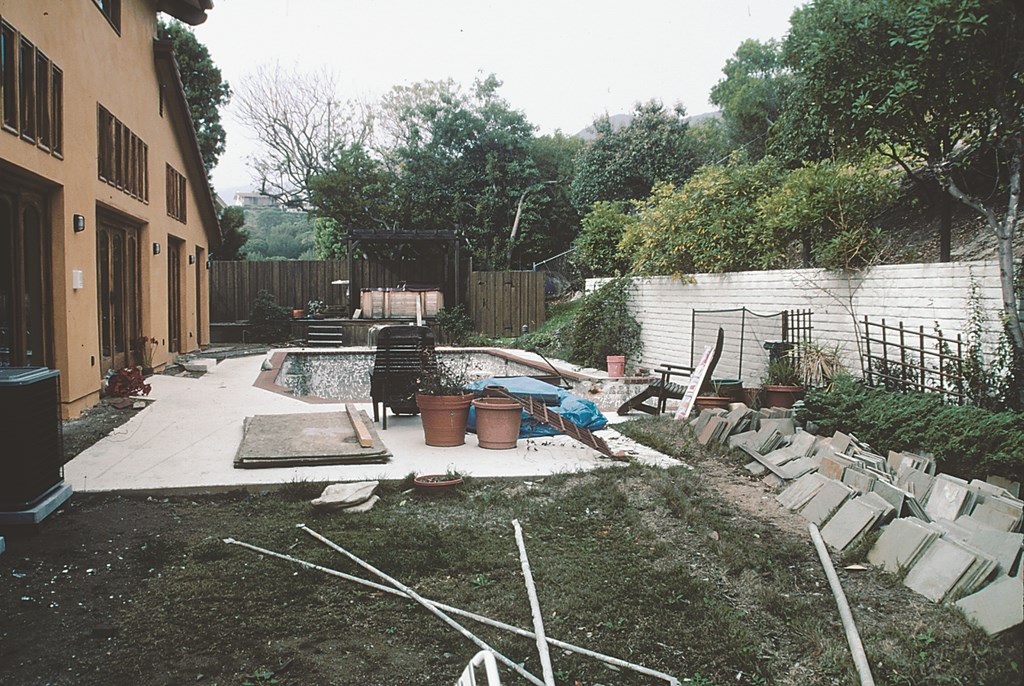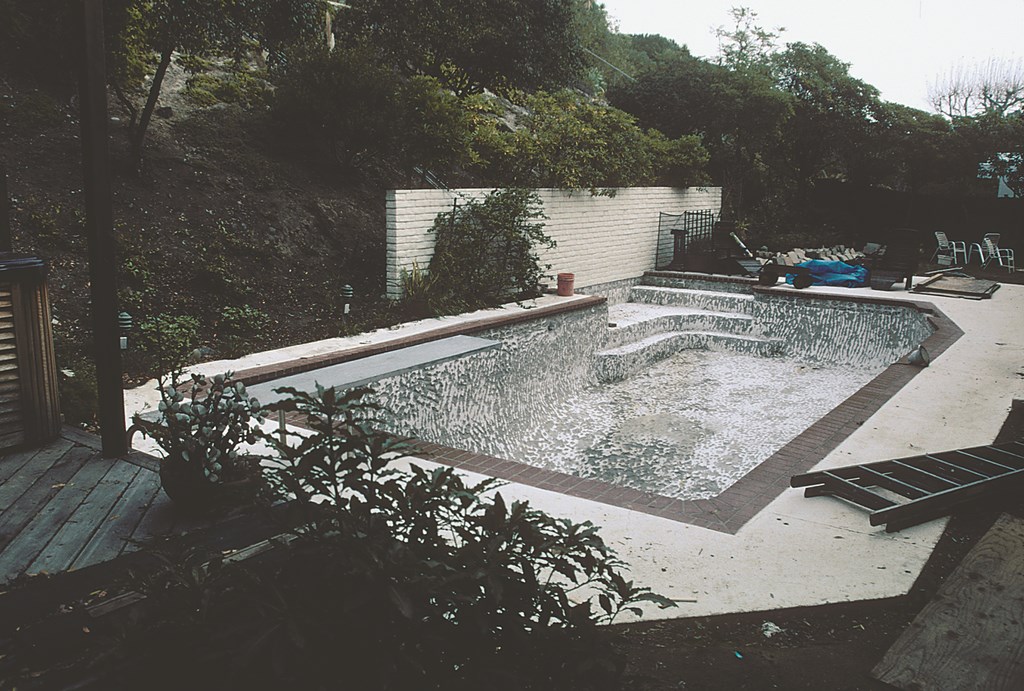The Currency of Beauty

For many people in the watershaping trades, client relationships begin with selling and never really advance beyond that stage.
For me, however, it’s not about selling per se; instead, it’s about creating a sense of collaboration and building a foundation of mutual trust and understanding. In fact, the work I do in establishing these creative relationships with my clients may well be the most important “detail” of all.
In a sense, watershaping isn’t a job to me. It’s my passion, which explains why I’m so obsessed with steel and concrete and water and what I can accomplish with them. It’s never about selling, and it’s not even about making money, although that’s certainly a byproduct of what I do. Instead, I’m in it for the craftsmanship (in the European sense of the word) and driven by the desire to create objects of enduring beauty.
With this mindset, making great art is not about extracting every dollar you can from the client. In fact, I’d go so far as to say that when I meet with clients, I’m not trying to sell them anything. Rather, I’m trying to inspire them with a vision of beauty and help them visualize what we can do with their property. If we decide to work together, it’s because I’m a good fit for them and they’re a good fit for me.
What this means is that there is no distinct point where a deal is closed: We simply arrive at the mutual conclusion that working together makes sense.
QUALIFYING POTENTIAL
This foundation of collaboration and mutual agreement runs counter to an approach to swimming pool sales where you always hear phrases such as, “leaving money on the table.” In fact, in my approach, I leave piles of it there more often than not.
Please don’t make the assumption that because I work with an affluent clientele that I’m always trying to sell them the most expensive this or that, whatever it may be. The truth is, I don’t care if a project includes expensive tile or not, or includes every conceivable bell and whistle. Instead, what I’m after is a selection of materials and an overall design that best fits the property and my clients’ tastes.
I’ll even say that I don’t really like being pigeonholed as a “high-end” builder: I have no problem designing and building projects with inexpensive materials so long as those materials are appropriate to the soil conditions and the structure of the watershape and are a good fit aesthetically.
None of this is to say that money doesn’t matter, because obviously it does. The distinction I’m trying to make is that the basis upon which discussions with clients proceed should be about inspiring passion in their hearts and minds rather than about extracting dollars from their pockets.
Yes, you need to ask questions about budgets and get that squared away, and everything I cover in client presentations is based on what I believe to be reliable information about their wherewithal: I’m no more interested than the next person in spending a lot of time developing design ideas without knowing how much my clients have to spend.
What I want to emphasize is that coming to know about clients’ budgets and whether or not I’m a good fit with them does not come down to a set of purely economic calculations.
As is the case with many top watershapers, all of my work comes through referrals. I don’t go out of my way to solicit work, nor do I follow up on random leads. When prospective clients call, I always find out how they got my name – which can have a great deal to do with whether or not I’ll get involved.
If they came to me through a soils or structural engineer, for example, I see that as a good referral because it indicates the clients are concerned right up front with proper engineering, which I consider my stock in trade. By contrast, if the contact has come from another builder, I might not get involved at all because there’s a good chance the customer is collecting bids. I do not make bids.
If clients call me because they like what they’ve seen of my work by visiting friends or social contacts I’ve worked for in the past and have decided they want my expertise, I consider these to be my strongest referrals. Past clients tell these prospects what I’m about, how I work and what they can expect. They’re prepared for my passion as well as my idiosyncrasies.
A NEW PROSPECT
Once these prospects and I clear the first hurdle, I’ll try to determine in general terms what they’re after. I start talking right away about their ideas, which tells me a great deal about their interests, their level of awareness of design issues and their degree of engagement with their surroundings.
If, for example, they jump right into discussions of a specific architect or a specific style – or if they mention one of the materials in the house that they particularly love – they’ve equipped me with important clues.
Just recently, I was referred to a couple living in Pacific Palisades, an upscale community in Southern California, by way of a landscape designer with whom they were working. They’d been encouraged to call me about installing a pool to replace the abomination of a swimming hole they had on the property.
| Convincing clients that they can trust you to turn a disaster area such as this one into a paradise that befits a great home can be easy if you know what you’re doing and can help the clients visualize their backyard’s future. |
The designer’s idea had been to build a naturalistic lake on the site, but that made no sense to me once I’d had a look.
As I pulled up to the house, I began noticing an array of stylistic influences on what could best be described as an ultra-custom home. The front yard was an unfinished wasteland, but the front door looming up over the clutter was made of padouk, an African hardwood with some of the most pronounced grain and coloring you’ll find in any species, and all of the window casings were made with the same wood. This was not standard millwork!
Another unusual touch was that the house had been finished with plaster (rather than the common stucco or siding) in a beautiful yellow/ochre hue – a real statement. The floors inside were concrete inlaid with slate trim and details. The kitchen was loaded with stainless steel, and there were high ceilings everywhere with wonderful transom windows.
A love for sailing ships had obviously inspired the basic home design: The second level was surrounded by catwalks, and standing on the second-floor balcony – with the breezes rising from the Pacific Ocean a couple hundred yards away – was remarkably similar to standing on the deck of a tall ship. In just a few minutes, I could see that the house was passionate and romantic – and definitely the product of owners deeply involved in its creation.
As I spoke with these intelligent and interesting people, I became more and more agitated about the landscape designer’s “lake.” It was all wrong in terms of scale and style and all wrong for the tastes of the clients. So when we finished our tour and sat down, my first comment was this: “I need to ask you, do you want me to talk about the landscape designer’s ideas, lie and say it’ll be beautiful, or do I tell you what’s wrong and go in an entirely different direction?”
The clients told me that I was there for a reason and asked me to speak my mind. Immediately, I knew that these were people with whom I could conspire to create something beautiful – and we were off and running.
ZEROING IN
It’s at this point in the process that I get more specific.
I start by breaking out my portfolio, which consists of three leather-bound albums filled with dozens of 8.5-by-11-inch, full-framed glossy photos. Two of the albums cover finished projects; the third is on details. There are no templates or cut-and-paste concepts, nor is this a catalog of every job I’ve done in the past 20-odd years: Instead, it’s a selection of projects that best exemplify what I do, in multiple views.
Every job on display in these books has been designed and built by me, and I understand every one of them from the inside out.
What I’m looking for as they flip through the books is information about clients’ likes and dislikes. I sort of view my role in this early stage as that of an investigative psychologist: I’m looking for the truth about my clients’ needs and what’s right for what is, after all, their environment and lifestyle.
I ask them if they entertain, for example, and how they see themselves using a pool. I find out if they’ve ever used a spa or if they’ve ever owned one (two very different things, lest we forget). I find out what artists they like and dig into their sense of style. My purposes here are twofold: I need to know what they’re after and what they like, and I also need to develop a sense of how hard I’ll have to work to help them visualize the potential I see in the spaces we’re contemplating.
|
The pool is too wide and deep, the retaining wall is unsound and the homeowners are being advised by another designer to install a lake-style pool. This is just the sort of starting place I enjoy most, because I know the clients and I can straighten things out and conspire to create something beautiful. |
As we go, I also break out a pad of paper and a set of pencils and pens. Then and there, I begin sketching out ideas and helping my clients grasp what words can only attempt to describe. It is this artistic visualization and our ability to begin seeing things together that is the basis of our working relationship, right from the start. If we can’t get to the point where they start to visualize, it just won’t work.
In the case of the Pacific Palisades project I’ve been discussing, we walked outside and began talking about how we might transform their environment. We talked about how we might use part of the existing pool’s structure while changing its shape and orientation to the house. We talked about how we might add a spa and how we could set up a secret garden that would be part of the home – yet slightly removed from it. We talked about color and how it would work with the overall design of the home.
In good order, we settled on a contemporary, bright, romantic color scheme. I’ll get into this subject a bit more in upcoming “Details,” but we determined that the pool would be finished in a red plaster – unusual, but in keeping with the setting – and that the walls and other hardscape materials would be salmon, blue, purple and lavender.
We also talked about setting up some spillways through a nearby wall to create additional visual interest. We discussed moving water and how we could use artificial lighting to create soft yet vibrant shapes on the walls through shadows, reflection and refraction. We touched upon entertainment areas and reserving a private meditation area. They were right there with me, beginning to see what could be done.
We also started talking about specific architects whose work I saw as compatible with the design principles they’d used in their home. We discussed Barragan and Le Corbusier and some lesser-known Southern California architects who’d done wonderful things with moving water. We also discussed Ricardo Legoretta, and I even suggested that they get their hands on a book about him because of the way he uses vivid, contrasting colors to create special spaces. Again, they were right there with me.
GETTING SET
All of this discussion took place during our first meeting. Although the design that followed would be more precisely realized and rendered, we set an extensive groundwork through this free-flowing session. By now we were kidding and laughing, everything was open and honest, and I could tell we were becoming comfortable with each other. The lake, happily, was nothing more than a gnawing, painful memory.
|
The Pride Factor Not long ago, I saw a line drawing on the desk of a pool builder who was attending the Genesis 3 Level I School. It didn’t impress me – just a vague sketch of a spa with no suggestion of materials, no detailing and no sense of how water flowed from the spillway. It was also out of scale with extremely distorted perspective. It was, basically, amateurish. That didn’t surprise me, because that’s how lots of builders’ drawings look before they take the course. What really struck me, however, was his statement, “My clients think it’s wonderful. And so do I.” What this told me – not the words themselves but the way he said them – was that he lacked real pride in his work. His willingness to pass off such an obviously inadequate drawing to a prospective buyer indicated to me that he didn’t much care what his clients thought about the project at hand or his work in general. It was clear he saw his rudimentary drawing skills as entrée to the ranks of professionals; the way I saw it, however, it was more like handing a 16 year old the keys to a Porsche without any driver training. As I hope I’ve demonstrated in the accompanying column, it’s far better (and easier) to build client relationships on pride and mutual respect than it is to start with smoke and mirrors and a vague contempt for what your prospects think. The point behind my work as an instructor is that drawing should be seen as a place where poor performance is simply not acceptable. It’s not about slapping lines on a sheet of paper and working out the details before construction begins; instead, it should be valued as a skill that: * helps clients visualize your ideas and get fully engaged in fine-tuning designs that meet their needs * takes the guesswork out of materials selections and set clients’ legitimate expectations about the way things ultimately will look in their backyards * speeds communication with contractors and subcontractors who have nothing to go on beyond what you communicate to them in visual form. As I tell my students, there’s just too much to be gained to treat either presentations or presentation skills lightly. — D.T. |
At this point, I gave them my price for designing the backyard in keeping with our discussion. I let them know that I charge for design work and that what they would get for their money was a set of plans that would be as complete as those done by any architect they could find.
The customers were eager to get started, and I suppose some would say that I “sold” them at that moment. But the fact of the matter is that they had sold me, too: Because of their passion and level of engagement in the process, the creative collaboration had already begun and we were getting ready to do great things together.
This is the way it works with almost all of my clients: I haven’t sold the Palisades couple a product; instead, we’ve agreed to work together to visualize and create a work of watershaping art that harmonizes with the work of art they call home.
That’s what it’s all about: What my clients are buying from me is a creative visualization of what they can have. Through my experience and the sense I’ve developed about what they want, I show them something beautiful and allow the work to stand for itself. That doesn’t mean we have to build an all-tile pool to make me or my banker happy: It’s about designing something that’s right for my clients and helping them see it.
If you can agree with me so far, then it all boils down to this: Aesthetics are the real currency in the process of creating quality watershapes, and they take precedent over everything. Good clients will see that immediately.
David Tisherman is the principal in two design/construction firms: David Tisherman’s Visuals of Manhattan Beach, Calif., and Liquid Design of Cherry Hill, N.J. He can be reached at tisherman@verizon.net. He is also an instructor for Artistic Resources & Training (ART); for information on ART’s classes, visit www.theartofwater.com.












